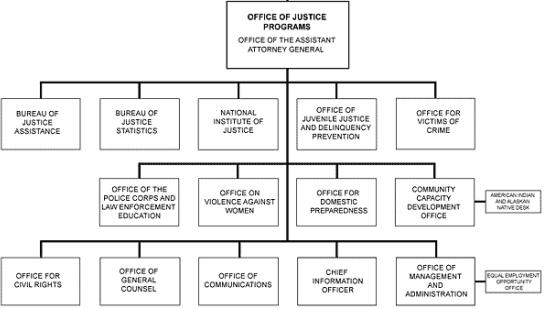
Source: OJP
| Return to the USDOJ/OIG Home Page |
Streamlining of Administrative Activities and Federal Financial Assistance Functions in the Office of Justice Programs and the Office of Community Oriented Policing Services
Report No. 03-27
August 2003
Office of the Inspector General
Within the Department of Justice (Department), the responsibility for managing Federal financial assistance programs is split primarily between the Office of Justice Programs (OJP) and the Office of Community Oriented Policing Services (COPS).1 The number and dollar value of Federal financial assistance programs managed by the Department have grown substantially over the last several years. The two offices awarded grants for about 96 programs and $5 billion for fiscal year (FY) 2002. The objective of our audit was to identify activities and functions that could be streamlined to increase operational efficiency within OJP and the COPS Office.
The Office of Justice Programs
Since its establishment in 1984, OJP has been tasked with providing grants to improve the nation's capacity to prevent and control crime, improve the criminal and juvenile justice systems, increase knowledge about crime and related issues, and assist crime victims. For FY 2003, OJP was authorized 729 full-time equivalent (FTE) positions and had a budget of about $4.2 billion.2 OJP is headed by an Assistant Attorney General and has recently undergone a reorganization of its structure and operations. According to OJP, the purpose of the reorganization is to become more effective, reduce duplication, and improve the delivery of services to grantees. OJP's current organization structure is shown in the following chart.
OJP's Organization Structure3
The major changes under OJP's reorganization were:
OJP's funding programs are divided into two main categories: formula grants and discretionary grants. Formula grants are awarded to State and local governments based on a predetermined formula using, for example, a jurisdiction's crime rate, population, or other factors. States are generally required to pass a significant portion of formula awards through to local agencies and organizations in the form of subgrants. Discretionary grants are awarded on a competitive basis to public and private agencies and private non-profit organizations. However, certain discretionary programs, such as funding to the Boys & Girls Clubs of America and the National Crime Prevention Council, are awarded on a noncompetitive basis, consistent with congressional earmarks. As shown in the following graph, OJP's bureaus and program offices awarded more than $31 billion in Federal financial assistance for FYs 1987 through 2002.
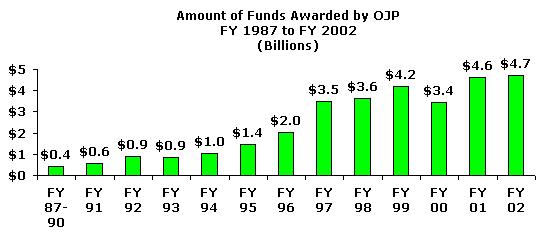
The Office of Community Oriented Policing Services
The COPS Office was established in 1994 as a result of the Violent Crime Control and Law Enforcement Act of 1994 (1994 Crime Act). The single largest component of the 1994 Crime Act was Title I - the Public Safety Partnership and Community Policing Act of 1994. The 1994 Crime Act authorized $8.8 billion over 6 years to fund the addition of community oriented policing officers and advance community policing nationwide. The COPS program was extended beyond FY 2000 by the FY 2001 Commerce-Justice-State Appropriations Bill. For FY 2003, the COPS Office was authorized 235 FTE positions and had a budget of about $923 million.4 As shown in the following graph, in FYs 1994 through 2002, the COPS Office awarded about $8 billion in grants in support of its mission to increase community policing.5
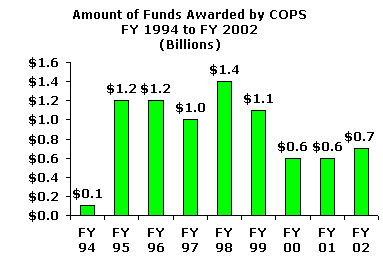
To implement the COPS program, in FY 1994 the Attorney General created the COPS Office as a separate office from OJP. The COPS Office is headed by a Director appointed by the Attorney General. At the time of our audit, it operated under the following organization structure.
The COPS Office's Organization Structure

On October 25, 2002, the COPS Office submitted a proposal to the Acting Assistant Attorney General for Administration to reorganize the COPS Office. Under the proposed reorganization, the COPS Office would have an Office of General Counsel and three deputy directorates that report to the Director. The COPS Office would have eight divisions, instead of the current seven, plus the response center. On February 11, 2003, the Attorney General approved the COPS Office's revised organization structure. As of March 19, 2003, the COPS Office's reorganization was pending approval by the Office of Management and Budget (OMB).
Audit Results
Our audit determined that Federal financial assistance programs in the Department are fragmented, resulting in reduced efficiency and higher costs to award and administer Federal financial assistance funds to State and local agencies. As described below, we made findings in the following areas: structural overlap between the COPS Office and OJP, overlap in grant programs between the COPS Office and OJP, lack of on-line grant application processing in the COPS Office, overlap in OJP's organization structure, and inefficiencies in OJP's automated grant management systems.
Structural Overlap Between the COPS Office and OJP
The Department's major financial assistance programs are split between OJP and the COPS Office, with both agencies awarding and administering grants to State and local law enforcement agencies that are sometimes for similar purposes. As illustrated in the following charts, from FY 1999 to FY 2002, the COPS Office's management and administration (M&A) costs per program dollar have been higher than OJP's, while COPS's M&A costs per grant administered have been lower than OJP's. However, COPS's costs per grant administered have been increasing while OJP's costs have been decreasing. If the trend continues, the COPS Office will spend more M&A costs per grants administered than OJP in FY 2004.
Comparison of Actual M&A Costs for COPS and OJP
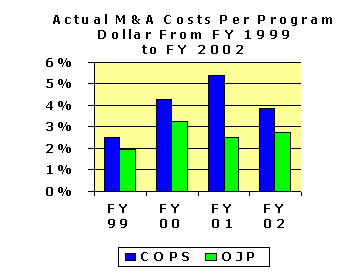
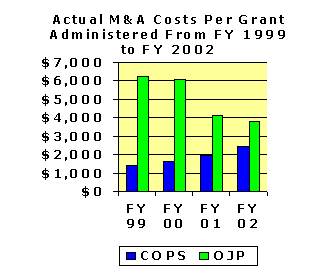
Source: Office of the Inspector General (OIG) Analyses of Actual Cost and Grant Award Data
The COPS Office's M&A costs per grant administered have been increasing because the grants administered by the COPS Office have been significantly reduced in recent years, but the COPS Office's personnel costs have not decreased correspondingly. OJP's M&A costs per grants administered have been decreasing because OJP has significantly increased its grants administered in recent years while keeping its personnel costs relatively constant.6
The COPS Office transfers significant portions of its appropriated funds to OJP to administer. Although these funds (known as pass-through funds) are appropriated in the COPS Office's budget, the COPS Office transfers the funds to OJP and, in most cases, OJP assumes full responsibility for management and administration of the funds. The COPS Office funds are passed through to OJP in various ways. Most of the funds passed through to OJP are mandated by Congress in the COPS Office's annual appropriations language, such as for the Police Corps program in FY 2002. The authorizing language in the COPS Office's approved FY 2002 budget provided that the Police Corps funds totaling about $14.4 million would be transferred to OJP to administer. In addition, the COPS Office passes funds to OJP through discretionary pass-throughs that occur when the COPS Office and OJP agree that certain funds in the COPS Office's budget would be either best managed by OJP or best managed jointly, such as for the jointly managed Comprehensive Indian Resources for Community and Law Enforcement (CIRCLE) program in FY 2001. In FY 2001, the COPS Office passed through $2 million to OJP for the CIRCLE program. The COPS Office also passes funds to OJP through earmarks that are legislative directives in the appropriations laws that dictate how to spend certain funds appropriated within larger funding programs. According to COPS officials, these funds are usually to continue projects previously administered by OJP or for programs that specifically fit within an existing OJP program. One such continuation project was the Safe Schools Initiative (SSI) in FY 2002. In FY 2002, COPS passed through $9,531,000 of earmarked funds to OJP for the SSI. As illustrated below, our audit determined that since FY 1999, the amount of funds that the COPS Office has passed through to OJP has steadily increased and reached almost 40 percent of the COPS Office's total budget by FY 2002.
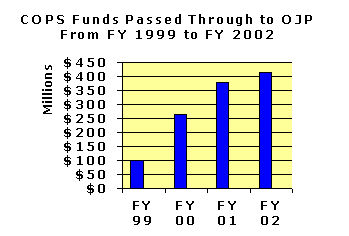
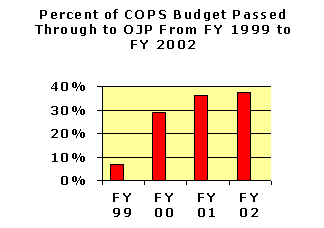
Source: OIG Analyses of Budget Data
In addition to pass-throughs, the COPS Office has also entered into reimbursable agreements each year for OJP to perform services to help COPS carry out its mission. These services have included making payments to grantees, preparing monthly treasury reports, entering grant obligations and deobligations in the financial system, processing and verifying electronic direct deposit information, and maintaining the Letter of Credit Electronic Certification System accounts, among others. From FY 1999 through FY 2002, the COPS Office shifted a total of about $16 million of M&A funds to OJP through the use of reimbursable agreements for OJP to perform services related to programs administered by the COPS Office. However, we did note that the COPS Office has taken steps to reduce its use of OJP services by assuming responsibility for some functions previously performed by OJP such as reviewing and approving final grant award budgets, providing financial management training to grantees, and coordinating with the OIG to resolve and close COPS grantee audit reports.
Overlap in Grant Programs Between the COPS Office and OJP
Our audit also identified overlap between the types of grants awarded by the COPS Office and OJP. For example, the COPS Universal Hiring Program (UHP) grants, Making Officer Redeployment Effective (MORE) grants, COPS in Schools (CIS) grants, COPS Safe Schools Initiative (SSI) grants, and COPS Secure Our Schools (SOS) grants are sometimes duplicative of grants awarded by OJP under the Local Law Enforcement Block Grants (LLEBG) program. While the LLEBG grants allow payment for a broader variety of costs than the COPS grants, the COPS UHP grants and CIS grants, as well as OJP's LLEBG grants, pay to hire officers to support community policing. Also, both the COPS MORE grants and OJP's LLEBG grants pay to hire civilians and to purchase technology equipment such as computers. In addition, both the COPS SSI and SOS grants and OJP's LLEBG grants pay to purchase equipment to help make schools safer. This overlap resulted when Congress created multiple programs to fund similar issues. However, both COPS and OJP officials told us that no formal communication procedures exist between the two agencies to ensure that grantees do not receive funds for similar purposes from both agencies.
Lack of On-Line Application Processing at the COPS Office
The COPS Office had developed an automated system, called the COPS Management System, to track its grants from application review to closeout. The COPS Office had also implemented several post-award functions online such as allowing grantees to provide information on grant progress using the "COPS Count" and performing account maintenance functions. However, we determined that the COPS Office had not developed a capability to receive grant applications online and download the application data directly into the COPS Office's grant management system. Potential COPS grantees must either mail, e-mail, or fax grant applications to COPS and then COPS must manually enter the application data into the COPS Management System for processing. COPS officials stated that the online application capability would be addressed as part of the e-government and Public Law 106-107 initiatives managed by OMB. The COPS Office had created and filled an e-government program manager position and established a business practices group to analyze its grant application process and provide information to OMB for development and approval of an online application system.
Inefficiencies in OJP's Automated Systems
OJP does not have a fully effective automated system to manage its Federal financial assistance funds. We found that OJP had more than 70 automated application systems in place. Some of these systems were developed by the individual components within OJP and duplicate information in other OJP systems. Despite having more than 70 automated systems to help manage its Federal financial assistance funds, OJP still relies primarily on a manual system for processing grants. OJP uses a "Redbook" to process grants from application through award. The "Redbook" is a manual binder for each grant awarded to a particular grantee that contains all documentation, such as the grant application, documentation on the application review, the award package, and supporting information. The "Redbook" is assembled and routed through various OJP components for review, analysis, and certification.OJP has made efforts to automate some of the "Redbook" process, and some "Redbooks" now use the automated Grant Management System (GMS).7 However, this process is not completely automated using the GMS. The GMS "Redbook" process allows the users to complete required forms in the GMS, but the forms are then printed out and maintained manually in the "Redbook." In addition, we noted additional inefficiencies related to the GMS system. Although we were told that the Assistant Attorney General for OJP said that all OJP components will use the GMS system, we found that GMS was used primarily by the program offices, and based on our interviews with GMS users, many users had complaints about the system. One drawback of GMS is that it only tracks grants from solicitation through grant award. The system does not maintain information on grant monitoring and closeout after the grant is awarded.
OJP recognizes that its automated systems need to be streamlined and as part of its reorganization OJP hired a Chief Information Officer, who began addressing the GMS-related issues. In addition, during our audit OJP hired a consulting firm to evaluate different alternatives for implementing an effective grants management system at OJP. The consulting firm evaluated the following four alternatives:
In its September 2002 report, the consultant recommended that the best solution for OJP would be to integrate the current GMS system with modules that would expand the system to manage grants from beginning to end. In our judgment, the consultant's report presented a convincing case for expanding the GMS system.
A helpful feature of the GMS is that it allows potential grantees to submit applications online directly into the system. However, as previously noted, the GMS system was used primarily by the program offices. OJP's bureaus, for the most part, were not using GMS. Some bureaus used other automated systems that have online application capability, but these systems were only used for 3 of the 47 grant programs administered by the bureaus. As a result, online application was not available for many grant programs administered by OJP bureaus. On January 17, 2003, the Assistant Attorney General for OJP mandated that all OJP bureaus and program offices use GMS to process grant applications electronically. OJP needs to ensure this mandate is implemented.
OJP's Overlapping Organization Structure
Within OJP, financial assistance programs are split among numerous bureaus and program offices, resulting in reduced efficiency in awarding and administering grants. The inefficient organization of OJP has long been recognized by Congress, OMB, and OJP itself, but numerous plans to reorganize and streamline OJP have not been implemented. The current OJP administration has developed another reorganization plan to streamline its operations and appears committed to implementing the plan. OJP has begun implementing this plan, which does contain some positive steps towards improving the efficiency and effectiveness of Federal financial assistance programs. Specifically, the plan calls for the creation of a Chief Information Office responsible for improving OJP's grant management system. OJP recently hired a Chief Information Officer (CIO) to head this office and the CIO has begun efforts to improve OJP's grant management system. OJP's reorganization plan also calls for major restructuring of its bureaus, program offices, and support offices to streamline its operations and reduce duplication and overlap between offices. While the restructuring is a positive step towards streamlining OJP's operations, we concluded that it would not eliminate all the duplication between OJP's bureaus and program offices. For example, we found that both OJP's Bureau of Justice Assistance and Office of Domestic Preparedness award grants for equipment and materials to help State and local governments respond to terrorist acts. However, these offices remained separate in the reorganization.8
Recommendations
In our report, we made eight recommendations to help improve the efficiency of OJP and the COPS Office. We recommended the Director of COPS and the Assistant Attorney General for OJP improve coordination between the two agencies to eliminate any duplication of effort and ensure that awards are not made to the same grantee for similar purposes. We also recommended that the Director of COPS continue efforts to implement an online application system for COPS grants that will allow potential grantees to complete grant applications online and that directly downloads the application data to the COPS Management System for processing. Further, we recommended that the Assistant Attorney General for OJP continue efforts to implement OJP's current reorganization plan and to identify and eliminate overlapping programs that will still exist after the reorganization is implemented. We also recommended that OJP take steps to ensure the: 1) "Redbook" process is automated, 2) implementation of the consultant's recommendation to integrate the current GMS system with modules that would expand the system to manage grants from beginning to end, 3) identification and elimination of duplicative automated systems within OJP, and 4) bureaus use the GMS system to enable online application capability for all bureau grant programs.